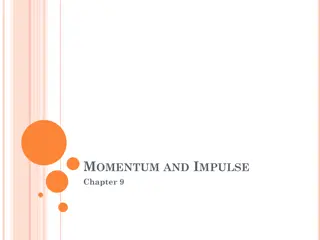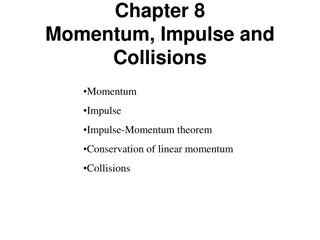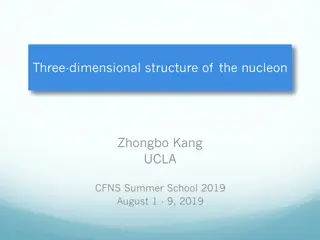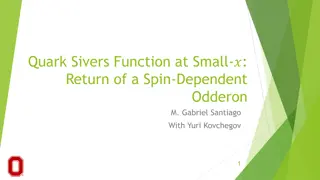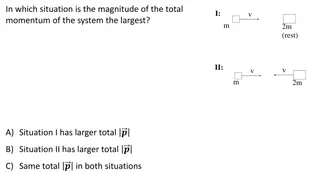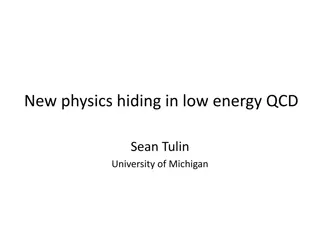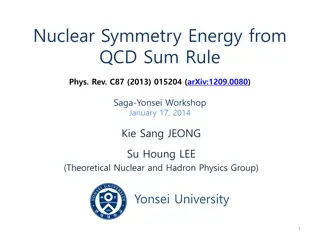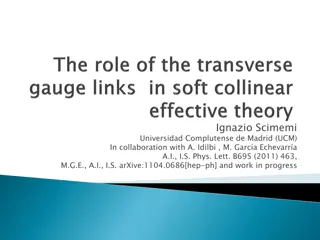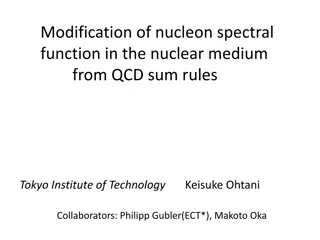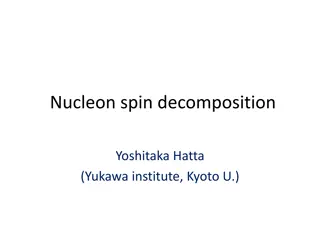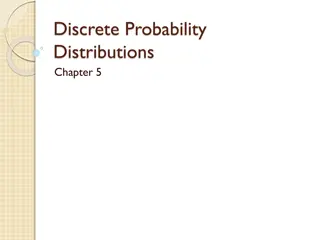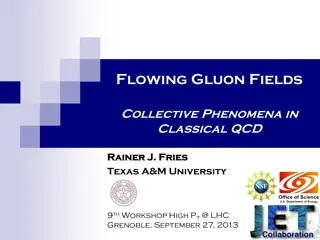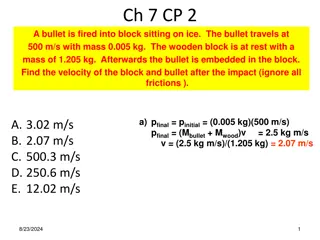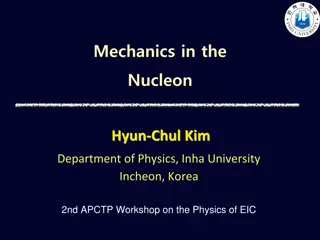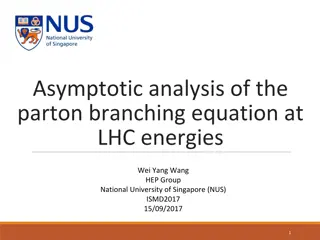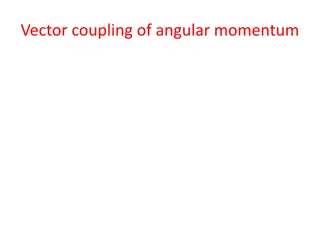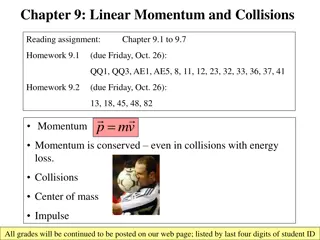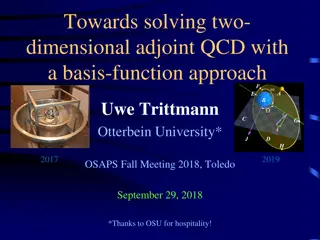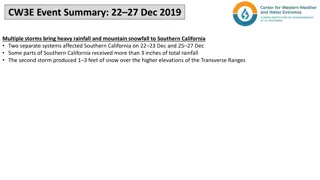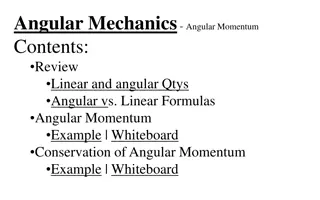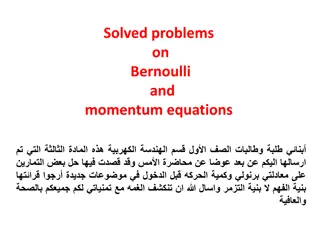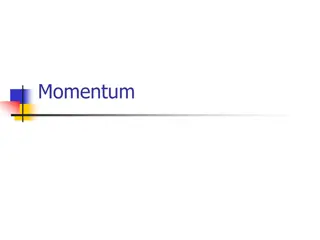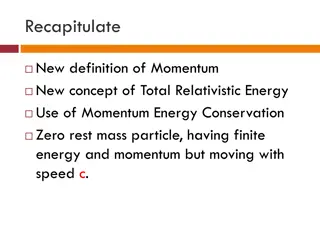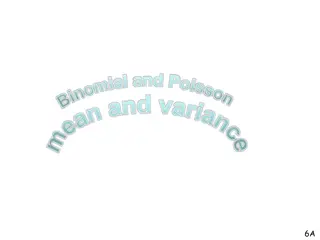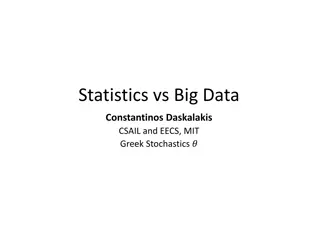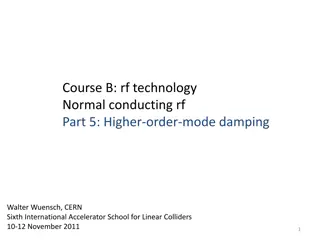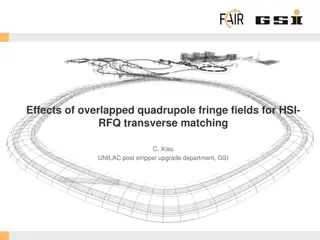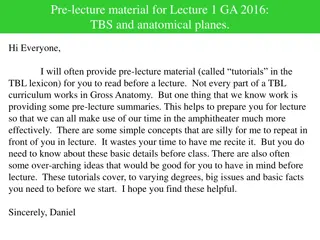Exploring Transverse Momentum Distributions (TMDs) at the GDR PH-QCD Annual Meeting
The Annual Meeting of the GDR PH-QCD focused on discussing Transverse Momentum Distributions (TMDs) and their significance at small kT and small x values. Topics covered include gauge-invariant correlators, PDFs, and PFFs, as well as the utilization of color gauge links in describing partonic transverse momentum. The event delved into the intricate details of TMDs, highlighting the importance of gauge links and color connections in understanding high-energy scattering processes.
Download Presentation

Please find below an Image/Link to download the presentation.
The content on the website is provided AS IS for your information and personal use only. It may not be sold, licensed, or shared on other websites without obtaining consent from the author. Download presentation by click this link. If you encounter any issues during the download, it is possible that the publisher has removed the file from their server.
E N D
Presentation Transcript
Annual Meeting of the GDR PH-QCD (December 15-17, 2014) Ecole Polytechnique, 16 December 2014 TMDs, offering opportunities at small kT and small x! Piet Mulders mulders@few.vu.nl 1
Outline TMD s: color gauge invariant correlators, describing distribution and fragmentation functions including partonic transverse momentum. Taking small pT out of the perturbative regime What are we talking about (definitions): gauge invariant description involves parton fields at different points, color-connected with gauge links/Wilson lines They can be measured in azimuthal and spin asymmetries provided one carefully accounts for right factors/signs etc. High/low energy, relations with small-x physics and diffraction 2
PDFs and PFFs Basic idea of PDFs and PFFs (also for TMDs) is to obtain a full factorized description of high energy scattering processes s =|H(p1,p2,...)|2 calculable defined (!) & portable s(P1,P2,...)= dp2... Fa(p1,P1;m) Fb(p2,P2;m) sab,c...(p1,p2,...;m) Dc(k1,K1;m).... dp1 Give a meaning to integration variables, including e.g. qT = p1T + p2T! 3
(Un)integrated correlators d4x (2p)4 ei p.xP y(0)y(x) P F(x,pT,p.P)= unintegrated d(x.P)d2xT (2p)3 TMD (light-front) ei p.xP y(0)y(x) P F(x,pT;n)= x.n=x+=0 = p integration makes time-ordering automatic. The soft part is simply sliced at the light-front d(x.P) (2p) ei p.xP y(0)y(x) P F(x)= x.n=xT=0 or x2=0 collinear (light-cone) Is already equivalent to a point-like interaction F= P y(0)y(x) P x=0 local Local operators with calculable anomalous dimension 4
Simplest gauge links for quark TMDs 2 ( . ) (2 ) d P d = [ ] q C ij . [ ] [0, ] i p C ( , x p n ; ) (0) ( ) e P U P T TMD T j i 3 = . 0 n Essential feature is the color connection of parton fields: gauge links originating from dimension zero (not suppressed!) A.n gluons (gluons polarized along parton momentum), but this is ambiguous for TMDs leading to process-dependence: SIDIS DY An An [-] [+] Time reversal AV Belitsky, X Ji and F Yuan, NP B 656 (2003) 165 D Boer, PJM and F Pijlman, NP B 667 (2003) 201 5
Some details on the gauge links (1) Proper gluon fields (F rather than A, Wilson lines and boundary terms) 1 P n P = + ) ... + = + ) ... + n T ( ) . ( n A p ) ( . ( n A p ) ( A p iA p p iG p 1 1 1 1 1 1 T . . p n 1 Resummation of soft n.A gluons (coupling to outgoing color-line) for one correlator produces a gauge-line (along n) Boundary terms give transverse pieces TMD s may have complex gauge links involving loops (linked to color flow) U = U+U
Simplest gauge links for gluon TMDs d(x.P)d2xT (2p)3 ab[C,C'](x,pT;n)= ei p.xP U[x,0] [C]Fna(0)U[0,x] [C']Fnb(x) P Fg x.n=0 The TMD gluon correlators contain two links, which can have different paths. Note that standard field displacement involves C = C [ ] [ , ] [ ] [ , ] C C ( ) ( ) F U F U Basic (simplest) gauge links for gluon TMD correlators: gg H g[-,-] g[+,+] g[+,-] g[-,+] C Bomhof, PJM, F Pijlman; EPJ C 47 (2006) 147 F Dominguez, B-W Xiao, F Yuan, PRL 106 (2011) 022301 in gg QQ 7
August 31, 2012 16:45 WSPC/ INSTRUCTION FILE Buffing-Mulders 4 M. G. A. Buffing and P. J. Mulders momentum qT of the produced lepton pair, d2p1Td2p2T 2(p1T + p2T qT) (x1,x2,qT) = [ ] 2 [ ] 1(x1,p1T) (x2,p2T) (x1,x2,Q), (10) which involvesa convolution of TMDs. What ismoreimportant, it is thecolor flow in the process, in this case neutralized in initial state, that determines the path in the gauge link in the TMDs, in this case past-pointing ones. In contrast in semi- inclusive deep inelastic scattering one finds that the relevant TMD is [+ ]with a future-pointing gauge link. In a general process one can find more complex gauge links including besides Wilson line elements also Wilson loops. In particular when the transversemomentum of more than one hadron is involved, such as e.g. in the DY case above, it may be impossible to have just a single TMD for a given hadron August 31, 2012 16:45 WSPC/ INSTRUCTION FILE Buffing-Mulders M. G. A. Buffing and P. J. Mulders because color gets entangled5,6. The correlators including a gauge link can be parametrized in terms of TMD PDFs7,8depending on x and p2 4 momentum qT of the produced lepton pair, T, d2p1Td2p2T 2(p1T + p2T qT) f[U] (x1,x2,qT) = [U](x,pT;n) = pTST T M T) f [U] + g[U] 1 (x,p2 (x,p2 T) 1s(x,pT) 5 1T [ ] 2 [ ] 1(x1,p1T) (x,pT) 5 /pT (x2,p2T) (x1,x2,Q), + ih [U] 1 (x,p2 (10) 2, T)/pT / P + h[U] T) 5/ ST+ h [U] 1T(x,p2 (11) 1s which involvesa convolution of TMDs. What ismoreimportant, it is thecolor flow in the process, in this case neutralized in initial state, that determines the path in the gauge link in the TMDs, in this case past-pointing ones. In contrast in semi- inclusive deep inelastic scattering one finds that the relevant TMD is [+ ]with a future-pointing gauge link. In a general process one can find more complex gauge links including besides Wilson line elements also Wilson loops. In particular when the transverse momentum of more than one hadron is involved, such as e.g. in the DY caseabove, it may be impossible to have just a single TMD for a given hadron because color gets entangled5,6. The correlators including a gauge link can be parametrized in terms of TMD PDFs7,8depending on x and p2 sities such as the Sivers function f q M M with the spin vector parametrized as S = SLP + S notations for g[U] 1s T + M2SLn and shorthand 1sand h [U] , T) pT ST g[U] 1s(x,pT) = SLg[U] g[U] 1L(x,p2 1T(x,p2 T). (12) M Color gauge invariant correlators For quarks, these include not only the functions that survive upon pT-integration, fq spin-spin densities(involvingquark and nucleon spin) but alsomomentum-spin den- 1T(x,p2 1(x) = q(x), gq 1(x) = q(x) and hq 1(x) = q(x), which arethewell-known collinear Including gauge links well-defined matrix elements for TMDs but this implies multiple possiblities for gauge links depending on the process and the color flow Leading quark TMDs polarized nucleon) and spin-spin-momentum densities such as g1T(x,p2 dinally polarized quarks in a transversely polarized nucleon). The parametrization for gluons, following the naming convention in Ref. 9, is given by T, T) (unpolarized quarks in a transversely T) (longitu- pTST T M f[U] T) f [U] + g[U] [U](x,pT;n) = 1 (x,p2 (x,p2 T) 1s(x,pT) 5 1T (x,pT) 5 /pT T)/pT / P 2, + h[U] T) 5/ ST+ h [U] + ih [U] 1T(x,p2 (x,p2 (11) 1s 1 M M Leading gluon TMDs: with the spin vector parametrized as S = SLP + S notations for g[U] 1s pTST T + M2SLn and shorthand T M p2 T 2M2 S } T T 4M Tfg[U] f g[U] 1T 2x [U](x,pT) = g T) + g (x,p2 (x,p2 T) 1sand h [U] , 1 T p M2 g Tp Tgg[U] h g[U] 1 T (x,p2 T) pT ST + i 1s (x,pT) + T) 1s(x,pT) = SLg[U] pT{ T T 2M2 g[U] g[U] 1L(x,p2 1T(x,p2 ST{ T). p } (12) T M p } pT{ T T+ h g[U] 1s hg[U] For quarks, these include not only the functions that survive upon pT-integration, fq spin-spin densities(involvingquark and nucleon spin) but alsomomentum-spin den- sities such as the Sivers function f q polarized nucleon) and spin-spin-momentum densities such as g1T(x,p2 dinally polarized quarks in a transversely polarized nucleon). The parametrization for gluons, following the naming convention in Ref. 9, is given by 1T(x,p2 (x,pT) T). (13) 1(x) = q(x), gq 1(x) = q(x) and hq 1(x) = q(x), which arethewell-known collinear 8 1T(x,p2 T) (unpolarized quarks in a transversely T) (longitu- pTST T M p2 T 2M2 S } 4M Tfg[U] f g[U] 1T 2x [U](x,pT) = g T) + g (x,p2 (x,p2 T) 1 T p M2 g Tp Tgg[U] h g[U] 1 T (x,p2 + i 1s(x,pT) + T) T pT{ T 2M2 p } T pT{ T ST{ T p } T T+ h g[U] 1s hg[U] 1T(x,p2 (x,pT) T). (13)
Operator structure in TMD case Operator product expansion takes you from local to nonlocal operator combinations. For TMD functions one can investigate this through transverse moments d(x.P)d2xT (2p)3 ei p.xP y(0)U[0,x] [ ]y(x) P F(x,pT;n)= x.n=0 d(x.P)d2xT (2p)3 d(x.P)d2xT (2p)3 aF[ ](x,pT;n)= ei p.xP y(0)U[0, ]DT aU[ ,x]y(x) P pT x.n=0 a1pT a2F[ ](x,pT;n)= a1DT a2U[ ,x]y(x) P ei p.xP y(0)U[0, ]DT pT x.n=0 Upon integration, these involve collinear twist-3 multi-parton correlators, they remain highly non-local and are U-dependent 10 MGA Buffing, A Mukherjee, PJM, PRD 86 (2012) 074030 , Arxiv: 1207.3221 [hep-ph]
Operator structure in TMD case For first transverse moment one needs (both) twist-3 quark-gluon correlators dx.Pdh.P (2p)2 dx.Pdh.P (2p)2 ei( p-p1).x+ip1.hP y(0)DT a(x-x1,x1|x)= a(h)y(x) P FD x.n=xT=0 ei( p-p1).x+ip1.hP y(0)Fna(h)y(x) P a(x-x1,x1|x)= FF x.n=xT=0 In principle multi-parton, but we need local FA dx1 x1 a(x)= a(x-x1,x1|x) 1 FF FD FD dx1 F(p-p1,p) a(x)= PV na(x-x1,x1|x) a(x)= FD a(x)-FA a(x) T-even (gauge-invariant derivative) F FG a(x)= pFF na(x,0|x) T-odd (soft-gluon or gluonic pole) 11 Efremov, Teryaev; Qiu, Sterman; Brodsky, Hwang, Schmidt; Boer, Teryaev, M; Bomhof, Pijlman, M
Operator structure in TMD case Transverse moments can be expressed in these particular collinear multi-parton twist-3 (and higher) correlators (which are not suppressed!) a[U](x)= aF[U](x,pT;n)=F a(x)+CG a(x) F [U]FG d2pT pT T-even T-odd T-even T-even T-odd ( ) ab[U](x)=F ab(x)+CGG,c ab(x)+CG ab(x)+FG ab(x) F [U]FGG,c [U]F G 5 Trc(GG ) Trc(GG) Trc( ) U[+ ]U[ CG[U] calculable gluonic pole factors U[ ] ] NcTrc(U[ ]) U[+ ] 1 U [U ] C[U ] G C[U ] GG,1 C[U ] GG,2 [ ] 1 1 0 [+ ] [( )+ ] 3 9 0 1 1 4 12 TABLE I: The values of the gluonic pole prefactors for some gauge links needed in the pT-weighted cases. Note that the value of C[U ] G is the same for single and double transverse weighting. link. In fact there is a universal transversemoment relating all link dependent ones f (1)[U] 1T (x) = C[U] Gf (1) (x). (15) 1T Although theonly differencefor thesingleweighted caseisjust thenumerical prefactor that for simpleprocessesisjust +1 or 1, wewill show in thenext section that for the doubleweighted casethesituation becomes morecomplicated and one actually gains a lot by this different notation. But even for single weighting there is a clear advantage using Eq. 15, because it states that there is a universal function with calculable process (link) dependent numbers rather than an infinite number of somehow related functions. For some gauge links, these numbers are shown in Table I. Here U[ ]is the Wilson loop U[ ] U[+ ]. C. Double transverse weighting In order to evaluate the double transverse weighting we need to consider matrix elements like d P 2 d P 2 d P 2 eix2( P )eix1( P )ei(x x1 x2)( P ) F F(x x1 x2,x1,x2|x) = P,S| (0) U[n] ( )U[n] ( )U[n] [0, ]Fn [ , ]Fn [ , ] ( )|P,S , (16) T T L C among others, where LC indicates that all transverse components and n-components of the coordinates are zero. Besides this matrix element one needs D F, F D and D D as well as bilocal matrix elements, obtained by direct or principal value integrations over these matrix elements (as in the case of single transverse momentum weighting) or gluonic pole matrix elements, where x1 or x2 or both are zero. Explicitly, the matrix elements are discussed in Appendix A. The actual weighting of the gaugelink dependent TMD correlator [U](x,pT) gives { } [U] d2pTp{ p } T [U](x,p2 (x) T) T = { } (x) + C[U] { } G (x) + { } 2C[U] GG,c { } (x) + GG,c(x) G G c = { } (x) + C[U] { } G (x) + { } (x) + 2C[U] GG,1 { } GG,1(x) + 2C[U] GG,2 { } GG,2(x). (17) G G For the correlators containing two (or more) gluon fields like the one in Eq. 16, one must distinguish the different color structures for the correlator, hence a summation over the color structures c. For double weighting, there are in the double gluonic pole part two possible color structures related to the appearance of the color traced Wilson loop 1 NcTrc(U[ as for the single weighted case in Eq. 9, the structures ... with one or more partial derivatives denote differences between correlatorswith a covariant derivative minus a correlator with a principal value integration, e.g. { } { } combination, we have symmetrized in the indices, which should not influence the result. We also omitted the Dirac indices on the fields. The precise form of all correlators in terms of matrix elements can be found in Appendix A. ]). The differences between the two different correlators { } GG,c(x) are made explicit in Appendix A. Just (x) = G D G(x) { } AG(x). For completeness, they aregiven in Appendix A. Sincetheweightingisdonewith thesymmetric
Distribution versus fragmentation functions Operators: Operators: out state D(k |k) ~ F[U](p| p) ~ P|y(0)U[0,x]y(x)|P X 0|y(x)|KhX KhX |y(0)|0 a[U](x)=F a(x)+CG a(x) F [U]FG a(x)=pDF na(1 DG Z)=0 Z,0|1 a[U](x)=D a(x) D T-even T-odd (gluonic pole) a(x)=pFF na(x,0|x) 0 FG T-even operator combination, but still T-odd functions! 13 Collins, Metz; Meissner, Metz; Gamberg, M, Mukherjee, PR D 83 (2011) 071503
Classifying Quark TMDs Collecting the right moments gives expansion into full TMD PDFs of definite rank While for TMD PFFs 14
Classifying Quark TMDs factor TMD PDF RANK 0 1 2 3 F(x,pT 2) F (x,pT F{G },c(x,pT FGG,c(x,pT F (x,pT F{G },c(x,pT F{GG },c(x,pT FGGG,c(x,pT F (x,pT FG,c(x,pT 2) 2) 2) 1 2) 2) [U] 2) CG,c CGG,c CGGG,c 2) [U] 2) [U] 2) Only a finite number needed: rank up to 2(Shadron+sparton) Rank m shows up as cos(m ) and sin(m ) azimuthal asymmetries No gluonic poles for PFFs factor TMD PFF RANK 0 1 2 3 D(z-1,kT D (z-1,kT D (z-1,kT D (z-1,kT 2) 2) 2) 2) 1 15 MGA Buffing, A Mukherjee, PJM, PRD2012 , Arxiv: 1207.3221 [hep-ph]
Explicit classification quark TMDs factor QUARK TMD PDF RANK UNPOLARIZED HADRON 1 f1 0 2 3 1 ^ [U ] h1 CG CGG,c [U] Example: quarks in an unpolarized target are described by just 2 TMD structures T-even T-odd [B-M function] ^[U](x,pT ^(x,pT 2)=CG [u]h1 2) h1 Gauge link dependence: 16
Explicit classification quark TMDs factor QUARK TMD PDFs RANK SPIN HADRON 1 f1, g1, h1T g1T, h1L 0 2 3 ^ ^(A) h1T 1 ^, f1T ^ [U] h1 CG CGG,c d f1, dg1, dh1T [U] ^(B1), h1T ^(B2) h1T A: y y =Trc yy B1: TrcGGyy B2: TrcGG Multiple color possibilities trace terms Trcyy 17
Explicit classification quark TMDs factor QUARK TMD PDFs RANK SPIN HADRON 1 f1, g1, h1T g1T, h1L 0 2 3 ^ ^(A) h1T 1 ^, f1T ^ [U] h1 CG CGG,c d f1, dg1, dh1T [U] ^(B1), h1T ^(B2) h1T Three pretzelocities: A: y y =Trc yy B1: TrcGGyy B2: TrcGG Process dependence in f1, g1and h1 (U-dependent broadening made explicit) f1 Trcyy [U]= f1+CGG,c [U]d f1 (Bc) ( ) ^(1)(A)+CGG,c ^(Bc)+h1T ^(1)(Bc) [U]=h1T+h1T [U]dh1T h1 18 B Boer, MGA Buffing, PJM, work in progress
Explicit classification quark TMDs factor QUARK TMD PDFs RANK SPIN HADRON 1 g1T, h1L f1, g1, h1T 0 2 3 ^ ^(A) h1T 1 ^, f1T ^ [U] h1 CG CGG,c d f1, dg1, dh1T [U] ^(B1), h1T ^(B2) h1T factor QUARK TMD PFFs RANK SPIN HADRON 1 D1, G1, H1TD1T 0 2 3 ^,G1T,H1 ^,H1L ^ ^ H1T 1 Just a single pretzelocity PFF 19
Explicit classification gluon TMDs factor GLUON TMD PDF RANK UNPOLARIZED HADRON 1 f1 0 2 3 ^(A) h1 1 d f1 ^(Bc) (Bc) [U] h1 CGG,c Note process dependence of unpolarized gluon TMD: g[U]= f1 g+CGG,c [U]d f1 g(Bc) f1 g^[U]=h1 ^(A)+CGG,c ^(Bc) [U]h1 h1 20 D. Boer (talk spin 20014): B Boer, MGA Buffing, PJM, work in progress
Some details on the gauge links (2) Resummation of soft n.A gluons (coupling to outgoing color-line) for one correlator produces a gauge-line (along n) The lowest order contributions for soft gluons from two different correlators coupling to outgoing color-line resums into gauge-knots: shuffle product of all relevant gauge-lines from that (external initial/final state) line.
Which gauge links? With more (initial state) hadrons color gets entangled, e.g. in pp Gauge knot U+[p1,p2, ] Outgoing color contributes to a future pointing gauge link in (p2) and future pointing part of a gauge loop in the gauge link for (p1) This causes trouble with factorization 23 T.C. Rogers, PJM, PR D81 (2010) 094006
Which gauge links? y(x2) y(02) [ ,0 ] [ , ] 1 1 + + [ , ][ , ] + + [0 , ][0 , ] 1 2 1 2 [ , ] [ ,0 ] 2 2 y(x1) y(01) Can be color-detangled if only pT of single correlator is relevant (using polarization, ) but must include Wilson loops in final U 24 MGA Buffing, PJM, JHEP 07 (2011) 065
NIKHEF 2013-028 Color entanglement for azimuthal asymmetries in the Drell-Yan process M.G.A. Buffing1, and P.J. Mulders1, 1Nikhef and Department of Physics and Astronomy, VU University Amsterdam, De Boelelaan 1081, NL-1081 HV Amsterdam, the Netherlands (Dated: September 18, 2013) In the resummation of collinear gluons emitted together with active partons from the hadrons in the Drell-Yan process (DY) effects of color entanglement become important when the transverse directions are taken into account. It is then no longer possible to write the cross section as the con- volution of two soft correlators and a hard part. We show that the color entanglement introduces additional color factors that must be taken into account in the extraction of transverse momen- tum dependent parton distribution functions (TMD PDFs) from azimuthal asymmetries. Examples where such effects matter are the extraction of the double Sivers and double Boer-Mulders asym- metries. Furthermore, wewill argue why thiscolor entanglement is a basic ingredient already in the tree-level description of azimuthal asymmetries. PACS numbers: 12.38.-t; 13.85.Ni; 13.85.Qk where and are the quark and antiquark correla- tors respectively, Fourier transforms of forward matrix elements of quark fields, and where and repre- sent the hard scattering interaction in which a virtual photon or weak vector boson with momentum q is pro- duced. The standard color factor emerges because the color trace is usually included in the definition of the correlator , i.e. Trc[1]/ (Trc[1] Trc[1]) = 1/Nc. This is also the basic expression of the TMD factorized parton model description after expanding into TMD PDFs. The result involves soft parts integrated over parton virtual- ities and is actually a convolution over the parton mo- menta pi = xiP + pi T. High-energy kinematics links the momentum fractions(or p+components) to scaling vari- ablesx1= P2 q/ P1 P2and x2= P1 q/ P1 P2and thesum of transverse momenta to the observable transverse mo- mentum p1T + p2T = qT q x1P1 x2P2, which is the transverse momentum of the virtual photon or the lepton pair with respect to the momenta P1and P2, see Ref. [5]. In theqT-integrated situation, collinear gluonsaresim- ply absorbed in the correlators as color gauge links. IN T RODUCT ION In Ref. [1] it wasshown that the inclusion of contribu- tions of collinear gluons in high-energy hadroproduction processes leads to the entanglement of color, complicat- ingfactorization of thecrosssectionsintoahard part and soft correlators. Collinear gluons refer to gluons emitted from each of thetarget hadrons, described by parton dis- tribution functions, with polarization along the hadron momentum. In Ref. [2] it was argued that this com- plication of factorization is even important at tree-level, where gaugelinks lead to color entanglement in the pro- cess, making it impossible to write a process with two initial state hadrons as the product of two correlators. These complications do not imply that observables can no longer be calculated, merely that results aredifferent from the naive picture and have a richer phenomenol- ogy. In this paper, we will focus on the Drell-Yan pro- cessonly [3] and show in moredetail what isdifferent and how this affects measurements of asymmetries. In this, we will go beyond the double weighted case in Ref. [2] and use the results of Ref. [4] to discuss in general all asymmetries accessible through Drell-Yan involving un- polarized or polarized TMD PDFsat leading order in an expansion in 1/ Q, often sloppily referred to as at leading twist . We will also show why this effect of color entan- glement is an essential ingredient, already at tree-level. 2 verse moments, yielding (m)(x,p2 T) pm (x,pT) = T( ), (3) m d (m) DY(x1,x2,q2 T) qm d DY(x1,x2,qT) = T( ),(4) m where the angle represents the angular dependence of thetransversevectorspT or qT, respectively and pm the symmetric traceless rank m tensor constructed from the transversemomenta, i.e. T( ) is |pT|m 2m 1e im . (5) p 1... m T = p 1 T ...p m traces T FIG. 2: The gauge connections contributing for Drell- Yan, indicated by gray blobs at the location in the diagram where they appear after resummation, the coordinates in brackets labelling the endpoints of the Wilson lines in co- ordinate space. The separations i are conjugate to par- ton momenta pi involving light-cone and T directions. The U gauge connections run to light-cone = . A ZIM UT H A L EX PA N SION OF T HE PA RT ON CORRELAT ORS By inverting these expressions, one can relate the def- inite rank TMDs (m)(x,p2 grated full TMD PDFs (x,pT) weighted with pm as explained in detail in Refs. [2, 4]. The definite rank functions appearing in the expansion for are actually quark or gluon correlators with in the matrix elements additional derivativesor gluonic fields, depending on the inserted operator being iD tually only particular combinations of these correlators. Performing the transverse momentum weightings is sen- sitive to the nonlocality of the operators, in particular T) to the azimuthally inte- T( ), Thecorrelatorsonly depend on momentum fractionsthat W ILSON LINES AT T REE-LEV EL areconjugateto light-likenonlocalitiesin theexpressions in terms of partonic fields. Gauge links are just sim- ple straight Wilson lines. At measured qT, determining the cross section for Drell-Yan includes gauge links with Correlators in description of hard process (e.g. DY) Theleadingorder Drell-Yan crosssection beforetaking into account gauge links, which are also leading order contributions, is illustrated in Fig. 1 and given by transverseseparations involving collinear and transverse gluons. In the process the color remains entangled as il- lustrated in Fig. 2. Bypassingthedetailsof gettinggauge links in the first place, we note that at measured qT the ingredients that contribute to the gauge links appear in different partsof thediagram and cannot betrivially ab- sorbed in the definition of the TMD correlators, nor can they beincorporated by asimpleredefinition of thecorre- lator. Therefore, thenamegaugeconnection rather than gauge link is used at this point. The result is Tor A Tdenoted as D, A, D D, etc. In thetreatment of TMD PDFsoneneedsac- FIG. 1: The DY process in the diagrammatic represen- tation, where the yellow blobs are described by the TMD PDFs. The and represent the hard scattering, pro- ducing a virtual photon. also the gauge links and their path. For example, for a TMD correlator with a gauge link U one finds d DY Trc (x1,p1T) (x2,p2T) 1 Nc (x1,p1T) (x2,p2T) , = (1) Complications if the transverse momentum of two initial state hadrons is involved, resulting for DY at measured QT in d DY = Trc U [U] d2pT p T [U](x,pT) (x) = (x) + C[U] = G G(x), (6) [p2] (x1,p1T)U [p2] where quark correlator including a covariant derivativeand the quark-gluon-quark correlator, while pole matrix element, corresponding to the emission of a collinear gluon of zero momentum [6]. These functions are collinear and independent of the gauge link. That dependence is only in the gluonic pole coefficient C[U] see Ref. [7]. For the simple staple gauge links U the gluonic pole coefficients are C[ ] havehigher moments, (x) = D(x) A(x) isthedifferencebetween a U [p1] (x2,p2T)U [p1] (2) G(x) is a gluonic 1 [ ](x2,p2T) , [ ](x1,p1T) = Nc suppressingall partsof the(partial) crosssection that are Just as for twist-3 squared in collinear DY not of direct importance for our purpose, e.g. the phase space factors. As arguments of the Wilson lines we have used a notation with the momenta p1 and p2 in square brackets, merely to indicate from which correlator the gauge connections receive contributions in the form of gluon emissions. Also, in Eq. 2 the dagger indicates the direction of thegaugeconnection in coordinatespace, as isexplained in e.g. Ref. [2]. In the attempt in thesecond expression [ ](x1,p1T) = Trc (x1,p1T)U is a color gauge-invariant TMD with a nontrivial (staple like) link running via light-cone minus infinity. In the above, both the TMD distribution functions and theDrell-Yan crosssection can beexpanded in trans- G, 25 = 1. Similarly, we G [U] (x) + C[U] + C[U] (x) = G { G}(x) GG,c GG,c(x), (7) etc. possibilities to construct a color singlet as is the case for a field combination GG , namely Trc[GG ] (c = 1) and Trc[GG] Trc[ ]/Nc(c = 2). For thestaplelikelinks only oneconfiguration is relevant, having C[ ] An extra index c is needed if there are multiple [p1]U [p1] GG,1= 1 and
3 C[ ] a unique parametrization of the gauge link dependent TMD correlators in terms of a finite set of definite rank TMDs depending on x and p2 gluonic pole factors [4], to a different color factor ascompared to thetermswith- out azimuthal dependence, one just has the 1/Ncof the splitting of color traces as in Eq. 1, though a trace con- taining color chargesarising from the gauge connections has to be included, giving Trc[TaTa] Trc[TaTa] Trc[1]= The minus signs in the second and third term in Eq. 10 come from the gluonic pole factor multiplying the G correlators. For the last term with two gluonic pole cor- relators, the color factor is GG,2= 0, see Ref. [4]. The weighted results also allow T, azimuthal tensors and 1 [U](x,pT) = (x,p2 Nc. T) +pT i pT i T) +pT ij M2 ij M2 ij i (x,p2 (x,p2 T) M T) +pT ij + C[U] i pT ij M2 ij G(x,p2 { G}(x,p2 T) G M C[U] GG,c GG,c(x,p2 + T). (8) c Trc[TaTbTaTb] Trc[TaTa]Trc[TbTb]= This implies not only a suppression of the asymmetry, but a sign changecompared to naiveparton calculations aswell. In general, for higher weightings, thecolor factor is given by a ratio of symmetrized color charges, 1 1 Nc. Depending on partons (quarks or gluons) and target, thereisamaximum rank, which for quarksin anucleon is rank 2. For gluonsin a nucleon one hasto go up to rank 3. Actually for thehighest rank, time-reversal symmetry does not allow a time-reversal odd rank 2 correlator, i.e. { G}= 0. Note that since the tensors pij Eq. 8 are traceless and symmetric, the correlators they multiply also must be made traceless in order to make the identification of the correlatorsunique. N2 c 1 T on the rhs of Trc[T{ a1...Tan}T{ b1...Tbm}T{ a1...Tan}T{ b1...Tbm}] Trc[T{ a1...Tan}T{ a1...Tan}]Trc[T{ b1...Tbm}T{ b1...Tbm}]. 1Tp For instance, the result of a weighting with p 1 contains, among others, a term 1Tp 2 2T A ZIM UT HA L EX PA NSION FOR T HE CROSS SECT ION N2 c+ 2 GG(x1) Nc 1 2 1 G(x2) , (11) (N2 c 2)(N2 c 1) where the minus sign originates from a gluonic pole co- efficient and a weighting with p 1 In this situation, the weighting has to be done with thetensorsq 1... m T , which isin principlestraightforward as qT = p1T + p2T, and thus involves a sum over various weightings. One gets at rank 2 among others contribu- tions 1Tp 1 2Tp 2 1Tp 2 2Tcontains 3N4 (N2 c 8N2 c 2)2(N2 c 4 c 1) GG(x1) 1 2 Nc 1 2 1 + GG(x2) . (12) These color factors [8] depend on the gluonic rank only and are insensitive to the presence of partial derivative terms. They in general imply a suppression of multiple gluonic pole contributions in azimuthal asymmetries. The resulting tree level crosssection for the Drell-Yan process at measured qT thus can be written as a sum of various contributions, each having their characteris- tic azimuthal dependence. There is color entanglement for gluonic pole contributions, but it is still possible to writea factorized expression for each term after inclusion of the full gauge links (resummed to all orders). For a 1 Nc [ ] (x1) [ ](x2) 1Tp p = (9) 1T D Y 2T D Y , with [ ] 2Tp p and similarly for as in Eq. 7. For the mixed contribution an additional complication arises because of the color entanglement of Wilson lines. Starting with Eq. 2 onefindstheexpanded expression expanded 1 1Tp (x1) p = (x2) 2T D Y Classifying Quark TMDs given harmonic -dependence in qT, there will not only bea split up in varioustermsdepending on polarizations of hadrons and partons, but there will also be a depen- dence on the gluonic rank of the functions with process dependent color factors. Formulated slightly more gen- eral for hadron-hadron scattering, each contribution in thesquared amplitudeisa convolution in transversemo- mentum (qT = p1T + p2T), but is also assigned an addi- tional color factor beyond the basic 1/Nc. Omitting the Q-dependence, one finds 1 Ncf[U1,U2] [U2](x2,p2T) (x1,x2), GG,c(x,p2 (8) relators, the color factor is Trc[TaTbTaTb] Trc[TaTa]Trc[TbTb]= This implies not only a suppression of the asymmetry, but a sign changecompared to naiveparton calculations aswell. In general, for higher weightings, thecolor factor is given by a ratio of symmetrized color charges, Nc 1 Nc 1 Nc 1 Nc G(x1) (x2) factor TMD RANK 0 1 2 3 (x1) G(x2) 3 F(x,pT 2) (10) F (x,pT F{G },c(x,pT FGG,c(x,pT taining color chargesarising from the gaugeconnections has to be included, giving Trc[TaTa] Trc[TaTa] Trc[1]= The minus signs in the second and third term in Eq. 10 come from the gluonic pole factor multiplying the G correlators. For the last term with two gluonic pole cor- F (x,pT F{G },c(x,pT F{GG },c(x,pT FGGG,c(x,pT F (x,pT FG,c(x,pT 2) 2) 2) 1 1 C[ ] to a different color factor ascompared to thetermswith- out azimuthal dependence, one just has the 1/Ncof the splitting of color traces as in Eq. 1, though a trace con- GG,2= 0, see Ref. [4]. The weighted results also allow G(x1) a unique parametrization of the gauge link dependent TMD correlatorsin terms of a finite set of definite rank TMDs depending on x and p2 gluonic pole factors[4], G(x2) . 2) 2) [U] 2) CG,c CGG,c CGGG,c [U](x,pT) = (x,p2 N2 c 1 2) [U] 2) To understand the prefactors one has to realize that the gluonic pole correlator acting on the gauge connection U [p1]. This leads to a gluon field inserted in the correlator (p1) and a color charge Taat the position of the gauge connection in Fig 2. For the second and third term this does not lead T, azimuthal tensors and [U] 2) G(x1) comes from a derivative 1 Nc. T) +pT i pT i T) +pT ij RG 1RG 2 [U1](x1,p1T) 4 (x1,x2,qT) M2 ij M2 ij i (x,p2 (x,p2 T) M T) +pT ij + C[U] RG for [ ] 1 T). i pT ij M2 ij G(x,p2 { G}(x,p2 are multiple directions. It should alsobenoted that theresultsin thispaper do not prove factorization. We have used the tree-level re- sult for Drell-Yan and shown that the inclusion of gauge links gives an additional color prefactor. Additional ef- fects, like the inclusion of next-to-leading order contri- butions or factorization breaking effects have not been taken into account. For the latter, see e.g. Ref. [12] for the case of hadroproduction in hadron-hadron scatter- ing. Other relevant material on the inclusion of trans- versemomentum for Drell-Yan can befound in Ref. [13], whileRef. [14] containsa niceoverview of issuesin TMD factorization. For instance, the result of a weighting with p 1 contains, among others, a term T) (13) G M [ ] 0 2 1 RG for C[U] GG,c + 0 1 1 c 1 1 N2 c+ 2 1 1 1 Nc. Depending on partons (quarks or gluons) and target, thereisamaximum rank, which for quarksin anucleon is rank 2. For gluonsin a nucleon onehasto go up to rank 3. Actually for thehighest rank, time-reversal symmetry does not allow a time-reversal odd rank 2 correlator, i.e. { G}= 0. Note that since the tensors pij N2 N2 c+ 2 c 2)(N2 (N2 3N4 (N2 c 2)(N2 c 8N2 c 2)2(N2 c 1 c 1) c 4 c 1) N2 c 1 2 1 (N2 c 1) 26 MGA Buffing, PJM, PRL (2014), Arxiv: 1309.4681 [hep-ph] TABLE I: Thefactor f pole ranks of both the quark and antiquark correlator in the Drell-Yan process. Eq. 8 are traceless and symmetric, the correlators they multiply also must be made traceless in order to make the identification of the correlatorsunique. [ , ] RG 1RG 2as a function of the gluonic T on the rhs of Trc[T{ a1...Tan}T{ b1...Tbm}T{ a1...Tan}T{ b1...Tbm}] Trc[T{ a1...Tan}T{ a1...Tan}]Trc[T{ b1...Tbm}T{ b1...Tbm}]. wherethecorrelatorsareexpanded asin Eq. 8, including the gluonic pole factors. The process dependent factors f[U1,U2] of the contributing terms in the hadronic correlators as well as on the gauge link structures of both TMDs. For Drell-Yan, all relevant factors for quark correlators have been tabulated in Table I. For processes more compli- cated than Drell-Yan a dependenceon thecolor flow pos- sibilitiesof both TMDswill appear, asmentioned before. This will be clarified in a future paper. As explained in Ref. [9], for gluons the expansion of the gauge link de- pendent correlators goes up to rank 3. p Nc 1Tp 1Tp 2 2T Summarizing, for hadroproduction processes gauge linkslead tocolor entanglement, which isalready thecase in the description of the Drell-Yan process at measured qT. Factorized expressionscan still beobtained, however, but they deviate from the naive expectation. It turns out that additional color factors have to be included in theexpressionsfor azimuthal asymmetries. Dueto these additional color factors, asymmetries are suppressed for Drell-Yan and lead to additional sign changes. These color factors [8] depend on the gluonic rank only and are insensitive to the presence of partial derivative terms. They in general imply a suppression of multiple gluonic pole contributions in azimuthal asymmetries. Theresulting treelevel crosssection for the Drell-Yan process at measured qT thus can be written as a sum of various contributions, each having their characteris- tic azimuthal dependence. There is color entanglement for gluonic pole contributions, but it is still possible to RG 1RG 2depend on the gluonic pole ranks RG1and RG2 A ZIM UT HA L EX PA NSION FOR T HE CROSS SECT ION N2 c+ 2 GG(x1) Nc 1 2 1 G(x2) , (11) (N2 c 2)(N2 c 1) where the minus sign originates from a gluonic pole co- efficient and a weighting with p 1 In this situation, the weighting has to be done with thetensorsq 1... m T , which isin principlestraightforward as qT = p1T + p2T, and thus involves a sum over various weightings. One gets at rank 2 among others contribu- tions 1Tp 1 2Tp 2 1Tp 2 2Tcontains 3N4 (N2 c 8N2 c 2)2(N2 c 4 c 1) GG(x1) 1 2 Nc 1 2 1 + GG(x2) . (12) 1 [ ] (x1) [ ](x2) 1Tp 1T D Y = (9) This research is part of the research program of the Stichting voor Fundamenteel Onderzoek der Materie (FOM) , which is financially supported by the Ned- erlandse Organisatie voor Wetenschappelijk Onderzoek (NWO) . We also acknowledge support of the FP7 EU-programmes HadronPhysics3 (contract no 283286) and QWORK (contract 320389). We would like to ac- knowledge discussions with Wilco den Dunnen, Asmita Mukherjeeand Wouter Waalewijn. All figuresweremade using JaxoDraw [15]. 2T D Y , with [ ] 2Tp and similarly for p expanded DISCUSSION A ND CONCLUSIONS as in Eq. 7. For the mixed contribution an additional complication arises because of the color entanglement of Wilson lines. Starting with Eq. 2 onefindstheexpanded expression Asdiscussed in Ref. [4], thereareonly two TMDswith agluonicpolerank 1that contributeat leadingorder, the Boer-Mulders function h At (total) rank 2, there are three universal Pretzelocity functions, h (A) 1T h (B 2) 1T with gluonicpolerank 2. All theother TMDsthat are relevant at leading order have a gluonic pole rank of 0. This implies that thefirst azimuthal asymmetries[10] whereaddional color factorsappear arethedoubleSivers asymmetry, which requirespolarized beamsand thedou- ble Boer-Mulders asymmetry, which is accessible using unpolarized hadron beams only [5], such as at the LHC. One might wonder why the gauge connections cannot be disentangled as in the collinear case, since the color charges are entangled in both cases. An attempt in this direction was made in Ref. [11]. The difference between the collinear and the TMD case, however, is that mul- tiple directions are involved, a light-like direction n in the Sudakov expansion of the momenta and transverse directions. These transverse directions are different for the gauge connections labeled with p1 and p2. For the light-likedirection n onecan at leading order in principle make one choice for the full process using the fact that varying n is 1/ Q suppressed. Having just one direction in thegaugeconnections, it isstraightforward to seethat theentanglement of gaugeconnectionscan beundoneby a gauge transformation, but complications arise if there 1T. writeafactorized expression for each term after inclusion of the full gauge links (resummed to all orders). For a given harmonic -dependence in qT, there will not only bea split up in varioustermsdepending on polarizations of hadrons and partons, but there will also be a depen- dence on the gluonic rank of the functions with process dependent color factors. Formulated slightly more gen- eral for hadron-hadron scattering, each contribution in thesquared amplitudeisa convolution in transversemo- mentum (qT = p1T + p2T), but is also assigned an addi- tional color factor beyond the basic 1/Nc. Omitting the Q-dependence, one finds 1 Ncf[U1,U2] [U2](x2,p2T) (x1,x2), 1and the Sivers function f (x1) 1 1Tp p = (x2) 2T D Y Nc 1 with gluonic polerank 0 and h (B 1) Nc 1 Nc 1 Nc and 1T G(x1) (x2) (x1) G(x2) 1 Electronic address: m . g. a. buf f i ng@ vu. nl Electronic address: m ul ders@ f ew . vu. nl [1] T.C. Rogers and P.J. Mulders, Phys. Rev. D 81, 094006 (2010). [2] M.G.A. Buffing and P.J. Mulders, JHEP 1107, 065 (2011). [3] S.D. Drell and T.-M. Yan, Phys. Rev. Lett. 25, 316 (1970); Erratum-ibid. 25, 902(E), (1970). [4] M.G.A. Buffing, A. Mukherjee and P.J. Mulders, Phys. Rev. D 86, 074030 (2012). [5] J.P. Ralston and D.E. Soper, Nucl. Phys. B 152, 109 (1979); X. Artru and M. Mekhfi, Z. Phys. C 45, 669 (1990); R.L. Jaffe and X-D. Ji, Nucl. Phys. B 375, 527 (1992); J.L. Cortes, B. Pire and J.P. Ralston, Z. Phys. C 55, 409 (1992); X-D. Ji, Phys. Lett. B 284, 137 (1992); W. Vogelsang and A. Weber, Phys. Rev. D 48, 2073 (1993); V. Barone, T. Calarco and A. Drago, Phys. Rev. D 56, 527 (1997); O. Martin, A. Schafer, M. Stratmann and W. Vogelsang, Phys. Rev. D 60, 117502 (1999); D. Boer, Phys. Rev. D 60, 014012 (1999); J. Sof f er, M. Stratmann and W. Vogelsang, Phys. Rev. D 65, G(x1) G(x2) . (10) N2 c 1 To understand the prefactors one has to realize that the gluonic pole correlator acting on the gauge connection U [p1]. This leads to a gluon field inserted in the correlator (p1) and a color charge Taat the position of the gauge connection in Fig 2. For the second and third term this does not lead G(x1) comes from a derivative RG 1RG 2 [U1](x1,p1T) (x1,x2,qT) (13)
Remember classification of Quark TMDs factor QUARK TMD RANK UNPOLARIZED HADRON 1 0 2 3 f1 1 ^ [U ] h1 CG CGG,c [U] Example: quarks in an unpolarized target needs only 2 functions Resulting in cross section for unpolarized DY at measured QT sDY(x1,x2,qT) = 1 Nc -1 Nc Nc F(x1, p1T) F(x2, p2T) contains f1 1 2-1qT abFG a(x1, p1T) FG b(x2, p2T) contains h1perp 27 D. Boer, PRD 60 (1999) 014012; MGA Buffing, PRL (2014) PJM, Arxiv: 1309.4681 [hep-ph]
A TMD picture for diffractive scattering y(x2) y(02) y(x2) y(02) q q [ ,0 ] [ , ] 1 1 X p2 k2 + + [0 , ][0 , ] + + [ , ][ , ] p1 GAP 1 2 GAP GAP 1 2 P P Y x1T x1T 01T 01T Momentum flow in case of diffraction x1 MX2/W2 0 and t p1T2 Picture in terms of TMDs and inclusion of gauge links (including gauge links/collinear gluons in M ~ S 1) (Work in progress: Hoyer, Kasemets, Pisano, Zhou, M) (Another way of looking at diffraction, cf Dominguez, Xiao, Yuan 2011 or older work of Gieseke, Qiao, Bartels 2000) 29
A TMD picture for diffractive scattering y(x2) y(02) q q [ ,0 ] [ , ] 1 1 X p2 k2 + + [0 , ][0 , ] + + [ , ][ , ] p1 GAP 1 2 GAP 1 2 P P Y x1T 01T Cross section involving correlators for proton and photon/ d(x.q)d2xT (2p)3 ei p2.x2g *(q) y(0)U[0,x] Fq/g[+](x2,p2T;q)= [+]y(x) g *(q) x.n=0 d2xT (2p)2 ei p1T.xPU[loop]-1P FDIF [loop](x1,p1T;P)=d(x1) x.n=0 30
Diffractive TMD correlator d2xT (2p)2 ei pT.xPU[loop]-1P FDIF [loop](x,pT;P)=d(x) no partons! x.n=0 Simplest transverse moment is rank 2 F0GG ab(x,pT;P)=pFFF ab(0,0) Leading to 31
Conclusion with (potential) rewards We study the (generalized) universality of TMDs via operator product expansion, extending the well-known collinear distributions (including polarization 3 for quarks and 2 for gluons) to TMD PDF and PFF functions, ordered into functions of definite rank. Theoretical and experimental relevance ! Multiple operator possibilities for pretzelocity/transversity and linearly polarized gluons ! The TMD PDFs appear in cross sections with specific calculable factors that deviate from (or extend on) the na ve parton universality for hadron-hadron scattering. ! Applications in polarized high energy processes, but also in unpolarized situations (linearly polarized gluons) and possibly diffractive processes. 32
Thank you 33





